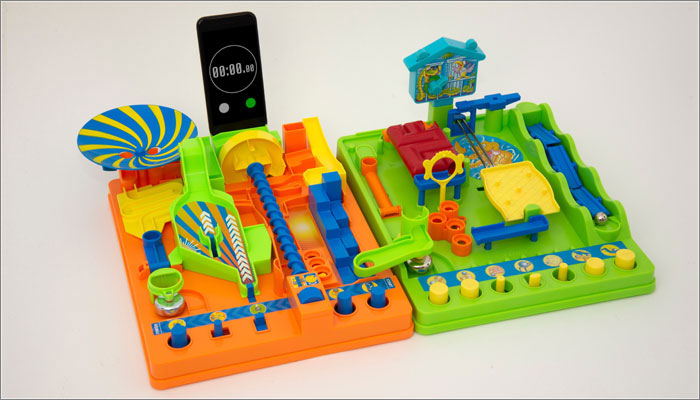TOMY team members Tom Yamazaki and Mizunuma-san on designing Screwball Scramble Level 2: a sequel that’s an equal!

Screwball Scramble is a mono, manic, marble-moving game that first hit shelves in 1979. Forty years on, the TOMY team launches a sequel that’s also an equal!
We climb the tilting walkway of curiosity to find out more…
Mizunuma-san and Tom Yamazaki… Thank you for doing this; what a pleasure. I don’t know the last time I got so excited at a Toy Fair as when I saw Screwball Scramble Level 2…
TY: Thank you for saying so! And for this interview too; it’s an honour.
More so for Mojo, I think… And I know this is a team effort so congratulations to all involved. I suppose the first question has to be, “Did you both play the original Screwball Scramble growing up?”
TY: I was a kid when it came out but wasn’t lucky enough to play with it. I grew up in suburban Tokyo making a lot of cardboard toys and games of my own. TOMY Games were always an aspiration on TV commercials and at local toyshops. And actually, I remember being upset when I saw the electronic car-racing game Digital Derby on TV… I seriously thought someone from TOMY had stolen an idea of mine with a tissue box and chopsticks!

MM: I joined TOMY in 1979 – the year Screwball Scramble came out – as a mechanic engineer in the R&D department. The games team was the first one I was assigned to… I clearly remember being a newbie, fascinated by the original pre-production samples – which one of the senior engineers was evaluating at a desk near mine.

Wow – so you saw the original in progress? In what way was it fascinating?
MM: The movements were all so interesting, especially the Tilting Walkway at the beginning. And the Parallel Bars! I couldn’t wait to work on such a brilliant product. Thinking about it now, it feels like this assignment at the starting point of my career led me to Screwball Scramble Level 2, after 40 years!
And with which other toys and games did you play?
MM: I played with marbles, Menko, Karuta and other playing cards… And many board games, just like other boys and girls of the same generation.
TY: I was really into ride-on car toys. I kept playing on them until they were battered and too small for me to hold onto properly… I had many injuries because of that – even some stitches! Memorable indoor toys included the early wind-up ZOIDS and LEGO Space; I spent a long time playing with my little brother.

And what’s your background? How did you come to work in the industry?
TY: As a teenager I was fascinated by cinematic special effects, I took many photos and movies of scale models I built, using Dad’s cameras. I wanted to be a visual innovator like Eiji Tsuburaya or Ray Harryhausen.
Oh my! Ray Harryhausen is incredible! The fighting skeletons are genius…
TY: Right?! Brilliant! Unfortunately, computer graphics seemed increasingly to be taking over at that time… I thought I’d better study something more realistic in terms of job opportunities. So I decided to follow the path of Industrial Design heroes I found in science fiction movies: Syd Mead, Ralph McQuarrie, and Giorgetto Giugiaro – I mean, who doesn’t love DeLorean?!
After graduating in Industrial Design at University, I chose the toy industry so I could create futuristic gadgets and space ships… Then I fell in love with this toy design job!

MM: Unlike Tom, I didn’t have that much of a vision… When I was studying at the Faculty of Science and Engineering in university, I vaguely felt I wanted a creative job. It seemed like I could end up being part of a large corporation if I joined a home electronics company or car manufacturer; something like that… But toy companies looked different. On top of that, TOMY offered a two-day weekend which was rare at the time!
A man after my own heart! Out of interest, why is it, do you think, that Screwball Scramble became so popular?
MM: The theme was based on outdoor obstacle courses which were becoming a trend in Japan at that time. I think my fellow seniors did a great job picking up on the attraction of real obstacles and putting them together as a miniature version.
TY: For me, it’s the striking, mechanical appearance. It gives you this urge; it just makes you want to play with it!

It’s pretty irresistible. And after all this time, whose idea was it to do Screwball Scramble Level 2? How did you come to work on it?
TY: As the lead designer of TOMY Games in Europe, I was tasked by Alpesh and the marketing team to leverage our classic, well-known games. A Screwball Scramble sequel was an obvious choice…
But where on Earth do you start?
TY: I started brainstorming in the office with colleagues. We allowed ourselves to free think, so it was great fun. We got many crazy ideas as a result! We were especially inspired by people posting “fastest Screwball Scramble” videos online. A great many were using mobile phones as a stopwatch! When we had some rough concepts, we searched for a mechanism expert in the Japan head office; someone who could help make it happen.
MM: And when this request came to me, the first thing I thought was: “After 40 years of proven success, they want to try and match that masterpiece? They must be mad!”
TY: Yes, perhaps we are!

So Screwball Scramble Level 2 is an obvious idea… And maybe it’s mad! Had it been tried before?
MM: Well, TOMY did release similar metal-ball games: a vertical type, a four-player version, a motorised one… None of them lasted long on our catalogues. Plus, even if we managed to make a new equivalent, the cost wouldn’t be the same… That said, I was motivated by my memory from 40 years ago. And I thought – since I’m semi-retired – this might be the last opportunity for me to really challenge myself.
And what were the biggest challenges? Did you set out to include or avoid certain ideas?
MM: At the start, I tasked myself with three goals. First, to be comparable: it had to have a play value sellable for another 40 years. Second, the new one shouldn’t cannibalise or replace the original… There had to be a reason for consumers to want both.
Right… I’ll come back to that. And third?
Third, I wanted it to capture the good characteristics of the original, yet add a new WOW. After that, I really needed to design and build the prototype from scratch on my own… So I shut my ears from hearing the opinions of others!

So there was a definite point where the creativity started narrowing?
TY: Yes; we had many different ideas for the same brief – but we weren’t sure which would work best practically… We had to let Mizunuma-san figure it out!
And from there, how easily can you walk us through how it came together?
MM: Well, I started by playing a lot with the original Screwball Scramble. Then I disassembled it, studied the structure, understood how it was made.
You literally broke it down?
MM: Yes. I felt it was essential to have a user-friendly interface with great controllability. I also thought it was important to have a sense of achievement; the feel you get with that satisfying bell sound after being rushed by a ticking timer!
So keeping these elements and the basic layout made sense with the idea of a bracket connecting the old and new games… That gives a reason to want both and – hopefully – these two products promote each other.

I was going to ask about the bracket. To me, that’s a masterstroke since it joins both games together side-by-side OR lets them stand alone. Was that a starting point in the design? Or a happy bonus?
TY: The connection bracket idea also came out in an early brainstorm. We strongly felt the two products needed to be compatible and expand on the play value.
MM: After that, I started thinking about the actual obstacles and actions… What would make them as good as the original game? Really, this was the biggest challenge! Browsing our idea sketches and other product information from the past, I kept drawing the actions and mechanisms I wanted to use. It was trial and error; I spent weeks completing this hand-drawn engineering drawing for the prototype.

Oh that’s marvellous! That really is; it’s like art to me!
MM: I also chose an amusement park or arcade theme… That works well across the markets. My equivalent to the Tilting Walkway and Parallel Bars are Zig-Zag Stairs and a simple Pinball.
Are they simple? I mean… You need skill!
MM: Well, yes! Both are simple, but unless done carefully and boldly, you will fail. Same as the original… Some parts of the game need to be like that – not too easy, not too hard – otherwise consumers get tired of the game, or find it irritating.
Yes; you’re right of course! You need a bit of skill, a bit of practise and a bit of luck… In fact, one obstacle is called Pot Luck: it’s a mini-hyperbolic funnel…
MM: Pot Luck is what I think gives it some WOW! The first prototype had only one hole. To be honest, it started more like a novelty action… You’d watch the ball roll around and around until it eventually dropped through a hole. But the idea of making two holes was a definite breakthrough. It brings in that luck element.

And were you watching all this unfold, Tom? Or waiting with bated breath?
TY: Oh, waiting! Mizunuma-san kept his prototype a secret until the final reveal. It was really only when we saw the video that we realised we’d got a winning concept!
What was the video?
TY: It was Mizunuma-san himself playing the test rig – with real passion! And it was so good! I just added music and subtitles and it was ready for our presentation meetings. From there, our team took over the development with the Hong Kong R&D team towards production.
You were saying in our emails that it was a real team effort?
TY: Yes, it really was! It’s an epic project with such a creative force… Our Product Designer Matt Jordan contributed on the style, colours and graphics, and the Graphic Designer Andy Tarrant did a brilliant job packaging both the new and the original-line look with contrast. Much of the same team created TOMY’s Greedy Granny in a Spin… It’s a novelty game based on a Japanese game – Karuta – that Mizunuma-san used to play as a child.

I’ll check it out! Before we start wrapping this up, I’m curious: is there anything you really wanted to include in Screwball Scramble Level 2 but felt forced to compromise on?
TY: Not really… The only slight compromise we had to make was excluding a wind-up timer, for costing reasons. Instead, we added a mobile-phone slot at the back… But actually that worked out really well because it resonates with the gamers online who inspired us in the beginning!
Ah! A restriction led to an advantage; lovely… Broadening it out then, let me ask you this: if you could wave a magic wand and make one thing easier about being a designer, what would it be?
TY: Oh, I’d definitely turn the whole team into little kids and test the toys ourselves!
MM: I’d like to create my own clones to generate more ideas & make models!
Perfect! Finally, then, what’s the most interesting thing on your desk or in your office?
TY: I have this solar-powered Einstein doll tapping his temple constantly… I bought it in Hong Kong thinking it was a “Think” sign… But my wife says it’s the sign for “Crazy” in France – so I like it even more!

Great! I have to double-check but I believe tapping the temple in the UK means “Think”… But spinning your index finger around in a circle by your temple means “crazy”… Then again, that signal for “crazy” is also sign language for “London”. Little bit insulting! Mizunuma-san, same question: what’s the most interesting thing on your desk?
MM: It’s the original Screwball Scramble of course!
Of course! I’d’ve been disappointed if you’d said anything else! Gentlemen, this has been a genuine pleasure; thank you again for your time. What a wonderful creation; I love it.
—-
To stay in the loop with the latest news, interviews and features from the world of toy and game design, sign up to our weekly newsletter here






















